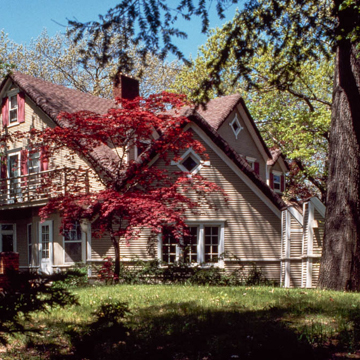You are here
Kemah Cottage (William and Alys Springer Cottage)
Kemah Cottage was built reportedly to the designs of Tallmadge of Chicago, a noted member of the Prairie School, for Fred S. Thompson (1854–1932), a Chicagoan who had summered at Saugatuck since 1896. Kemah, an Indian word for “In the Teeth of the Winds,” is an appropriate name for this breezy spot on Allegan Hill above the lake, which was also the site of an Indian burial mound. The house was sold in 1926 to William Springer (1884–1941), also from Chicago, who was a member of the Chicago Board of Trade. A few months later, Kemah was damaged by fire, and Springer and his wife, Alys, hired Hoerman to remodel the house. Hoerman (1885–1955), a Bavarian-born architect and artist well-known for his landscape paintings, who was a friend of the Springers, designed for them a personal and inspired reflection of their interests.
The Saugatuck Commercial Record for 1932 described the transformed Kemah Cottage as “a delight to the eye because of its charming roof line, quiet dignity, and artistic landscaping,” and as “a distinguished example of the ‘House Beautiful,’” in which every detail accounts for itself in artistic terms.
The house is a modified English cottage design with a false thatched roof. It has a varied roofline with many gables, clapboard siding, and a large columned porch, as well as a porte-cochere. Every aspect of the interior was created by Hoerman as well—Art Nouveau and Wrightian stained glass windows, hand-carved wood panels and doors, light fixtures, and wrought-iron grilles. The solarium features a fountain, whose base comprised rocks gathered on a western trip taken by Mrs. Springer and Hoerman, and a massive stone fireplace. A verse over the window reads, “In rain and shine, my port divine, A world my own, Kemah my home.” The basement has a rathskeller with its original fittings.
Writing Credits
If SAH Archipedia has been useful to you, please consider supporting it.
SAH Archipedia tells the story of the United States through its buildings, landscapes, and cities. This freely available resource empowers the public with authoritative knowledge that deepens their understanding and appreciation of the built environment. But the Society of Architectural Historians, which created SAH Archipedia with University of Virginia Press, needs your support to maintain the high-caliber research, writing, photography, cartography, editing, design, and programming that make SAH Archipedia a trusted online resource available to all who value the history of place, heritage tourism, and learning.


